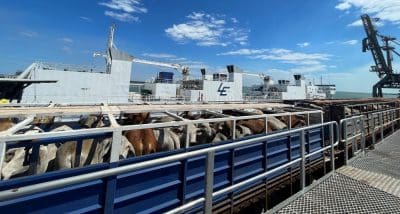The cause of the deaths of over 100 Australian cattle on a livestock shipment to Indonesia last weekend, and a further 50 cattle from the same cohort which simultaneously died at an export quarantine facility near Darwin, is still yet to be determined, officials say.
 Territory and Federal Government veterinarians have been conducting investigations and testing cattle over the past week.
Territory and Federal Government veterinarians have been conducting investigations and testing cattle over the past week.
The Department of Agriculture has stated the cause is not believed to be a contagious or exotic disease, with a toxin such as Botulism ingested through a dietary source considered a potential source.
The Department noted that detecting botulism through tests is often difficult because of the low amounts of toxin present in the bloodstream of affected cattle.
“As a result, testing for botulism is a process of elimination and will take some time.”
Indonesia has temporarily suspended cattle exports from the pre-export-quarantine facility which handled the affected cattle, the Department of Agriculture confirmed this afternoon (see full statement below).
What is known about the cattle deaths so far
About 3300 mainly Brahman and Brahman-cross cattle which had been assembled at a pre-export quarantine facility south of Darwin were loaded onto the Brahman Express at the Port of Darwin last week for export to two Indonesian ports for three customers.
Under Australian Standards for the Export of Livestock (ASEL), the cattle on the shipment were assessed by a Government appointed veterinarian and an exporter-appointed third-party veterinarian just prior to loading and were deemed healthy and fit to load.
Among the consignment was a group of cattle sourced from a single property between Alice Springs and Tennant Creek.
The cohort from that property was split two ways in the yards, with some incliuded in the consignment which was loaded onto the Brahman Express, and the balance remaining in the yards for export on the next vessel to Indonesia.
About four days into the Brahman Express voyage, around 100 cattle from the Alice Springs group on the vessel began displaying signs of sickness.
Simultaneously, about 50 cattle from the same property in the export yards also began showing similar signs of illness.
All of the sick cattle died within days of first symptoms appearing.
Of the remaining cattle on the vessel and in the yards from different properties, none displayed signs of sickness and 100 percent were delivered in a healthy condition with no mortalities, Beef Central understands.
Botulism is currently the working theory as to the likely cause – more information about it can be read in this NT Government fact sheet. It is understood the vendor who owns the Alice Springs property has stated the cattle were vaccinated for botulism.
Sources say vaccinated cattle can still be susceptible as the vaccine efficacy can diminish over time, faulty vaccine batches can occur, and unintentional misuse of the vaccine at application can also render vaccines ineffective.
It is also understood that results from lab tests have ruled out other possible causes such as tick fever or pasteurella pneumonia.
Department of Agriculture update
In the meantime, the Department of Agriculture issued the following update this evening (5pm):
Australia has received confirmation from the Indonesian authorities that the export of live cattle from a particular registered establishment in the Northern Territory has been temporarily suspended, pending further investigations to determine the cause of the incident.
The suspension follows the confirmed mortalities on-board the Brahman Express.
The department continues to investigate the cause of the livestock mortalities. Clinical signs present in the cattle are consistent with botulism.
The department is committed to working closely with our international trading partners to provide assurance that all animals exported from Australia comply with their animal health requirements.
Australia is confident that there is no evidence of an exotic disease, and our animal health status remains unchanged.
Earlier update 12:30pm:
The department is aware that Indonesia may temporarily suspend the import of live cattle from one Australian facility pending the finalisation of the investigation of recent cattle deaths on the Brahman Express.
The department is awaiting official correspondence from Indonesia to confirm this.
The department continues to cooperate with Indonesian officials to provide assurance in relation to the circumstances and will provide a report to them at the conclusion of the investigation.
The department continues to investigate the cause of livestock mortalities reported on the Brahman Express.
Clinical signs present in the cattle appear to be consistent with botulism.
Botulism in cattle is most often caused by the cattle eating a toxin produced by bacteria in contaminated feed. It is not a contagious or exotic disease and is not a risk to the Australian herd or to human health.
Detecting botulism through tests is often difficult, owing to the low amounts of toxin present in the bloodstream of affected cattle. As a result, testing for botulism is a process of elimination and will take some time.
Testing undertaken at the Northern Territory Government’s Berrimah Veterinary Laboratory has excluded Bovine Ephemeral Fever and tick fever as possible causes of mortality.
A number of other tests are still underway as part of the investigation.
Australia is confident that there is no evidence of an exotic disease, and our animal health status remains unchanged.
The department is committed to working closely with our international trading partners to provide assurance that all animals exported from Australia comply with their animal health requirements.
